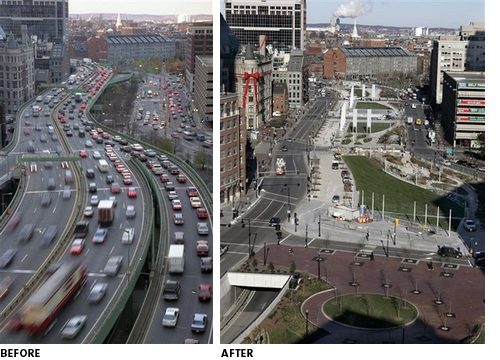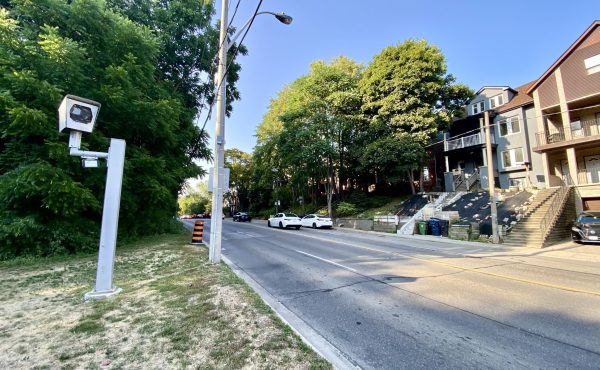
BOSTON — The most widely publicized attempt to rejuvenate a city scarred by an elevated expressway concludes today: Boston’s Big Dig has officially come to an end. The underground tunnels replacing the above ground I-93 are now fully operational.
To give you an idea of the scope of this kind of project, Michael Dukakis, the Democratic presidential candidate who lost spectacularly to George H.W. Bush in 1988, was ending his term as Massachusetts governor when the Big Dig started.
As an Associated Press article describes, it was a construction project to rival anything an urban environment has ever seen. At $12 billion and five years late in arrival, its story involves engineering wonderwork, corruption, and a tunnel collapse that led to a manslaughter charge against a contractor.
The actual mechanics of the Big Dig are probably well-known to engineering enthusiasts, as they faced the problem of trying to create an underground expressway without de-stabilizing the elevated expressway that still lay above it.
Most other people will take pleasure in this astonishing series of before and after pictures, many of which have been taken as sections of the expressway have been replaced over the past few years.
While all underground aspects of the project are finished, about 18 months of above ground work remain, including the final destruction of what remains of the expressway. The project will open up 30 acres of land in the downtown core.
Also check out a series of photos on Flickr dedicated to the new green space created by the Big Dig.


21 comments
The City of Boston’s website is actually http://www.cityofboston.gov/
Boston.com is the website of The Boston Globe.
what an amazing project, too bad we don’t have politicians with a vision to transform the waterfront.Instead we will be inundated with condos that block out the sun and leave little space for anything else.A real disappointment indeed.
The railway could be used to build a new roadway/rail/subway combination and allow the gardiner to be removed. Instead we will be building a front street extention right through the heart of a residential area.Oh well!!!
And beware that the Boston.com web site linked hasn’t been updated for four and a half years, so the “future” plans on it have already been debated, refined, and in most cases, built.
I happened to be in downtown Boston in June. It might not be fair for me to evaluate it, since I don’t recall what it looked like before, I hadn’t studied the plans, and they were still finishing park construction, but I found it kind of blah. The corridor still cuts the city in two; it’s just a green scar now. It’s too wide to be a landscaped median but too narrow to feel like much of a park. Based on the lack of traffic through the parts that were open, I’d wager it will be lightly used. All in all, for $12 billion, the transformative value seemed pretty weak to me.
I think the vision Toronto politicians need is one that embraces the Gardiner Expressway and Lakeshore Blvd. as vital parts of the city’s fabric. Instead of thinking of them as an ugly blemishes and turning their backs on them, or trying to wish/complain them away, it would be nice if the city were to quit whining, and move forward with making improvements to what’s already there. For the fraction of the cost and time of the Big Dig, the Gardiner and Lakeshore could be transformed into something far less offensive than what’s there now. Something beautiful, multi-use (by reclaiming abandoned spaces), and pedestrian/cyclist friendly even. I would be thrilled if politicians would finally stop this paralyzing debate/dreaming about burying the Gardiner and instead start dreaming about a future that isn’t any less wonderful, but is infinitely more doable.
melissa> I keep hearing those sort of ideas talked about, so perhaps that’s what will happen. “Bury the Gardiner” may be a thing of the past.
Anyone know how this project was financed?
Adam: $8.5 billion in federal money; I believe the rest of it was from the state. Overruns more than doubled the cost of the project, and apparently some of the contractors are being sued for quality/safety issues.
Shawn and Melissa: I hope so. It had gotten far too fashionable to blame everything on the Gardiner (either as an excuse for doing nothing, or as a general-purpose rant).
And a clarification on my own earlier comment: I meant “foot traffic” was light in the parks. I’m sure the tunnels get plenty of car traffic.
What I want to know is why is nobody talking about expanding the Gardiner? Lets build another level on top and ease congestion, maybe even remove another street elsewhere as compensation. Lets put ALL of of freeway traffic into one mega-freeway. Just kidding.
Your article credits me for the photos that appear in it. But though your HTML link (“series of photos”) does go to my Greenway set on Flickr, the shots that actually appear on this page are somebody else’s. Their attribution to me should be corrected.
Melissa – see John Lorinc’s essay on the Gardiner Expressway Transformation Study proposed by John van Nostrand and Calvin Brook. It’s here: http://johnlorinc.ca/archives/divided%20highway%203.03.pdf
If you’re really interested, there’s the official one here: http://www.towaterfront.ca/dbdocs/451ad1fc5015e.pdf
Boston Big Dig funding – all the current estimates seem to be $14.6B up from the original estimate of $3.175 in 1987. The Mass Turnpike Authority official report splits it 49% federal; 11% Massachusetts; 12% MTA; 2% Massport; 10% Grant Anticipation Notes (GANs); and 16% Transportation Infrastructure Fund Bonds. At some point, federal funding will replace the GANs, which brings the feds amount to 59%. Just imagine Ottawa kicking that amount to the TO waterfront…
Don’t forget too that a lot of projects like this get funding boosts from tolls. We could have a $5 toll on the Gardiner and nobody would blink — let daily commuters get a multipass, etc. Then you’ve got access to cash for subways and velotubes, etc.
GB
Burying the Gardiner would just be a hugely expensive accommodation of automobiles. Where is it written that drivers have divine right to barrel through the hearts of cities, whether above or below ground, with total disregard for surrounding neighbourhoods?
Mending the original street grid/urban fabric a la Regent Park is the way to go.
@Matt L: I know exactly what you mean. Admittedly this is preferable to a freeway, but the North End feels only marginally less cut off than it used to. Not a lot of improvement for $18Bn, or whatever it was–especially considering that the T got nothing out of the Dig except for the ludicrous Silver Line.
Oh puhlease. I wish people would do their homework before they start raving about stuff.
Funnomad, if you charged $5 a day, you’d only generate $130M per year at 100,000 cars per day along the Gardiner (based on 260 work days per year). That won’t buy you a cup of coffee when it comes to infrastructure funding.
The Gardiner isn’t going anywhere soon. You’d still be left with the elevated rail lines….which by the way were the subject of a HUGE fight back in the 20’s when Union Station was built. The station was built to accommodate either grade or elevated tracks. The tracks were finally elevated to rectify the fact that people were getting KILLED trying to cross them, (check out the City archives to see some pictures). Now, imagine getting rid of the Gardiner and having that much traffic at grade. Want to see the downtown get assaulted by the car??? Just do that. Oh, and by the way, you can’t bring the tracks down to grade either as they will be an integral part of the flood control mechanism for the Don…so there ya go, a barrier to the waterfront to keep people from drowning or getting splatted by a GO train.
Maybe instead we should spend a few bucks cleaning up the area underneath and surrounding the elevated portion and celebrate the fact that the car is out of the way.
People like Ed seem to think traffic is a force of nature or an act of God as if an equal number of vehicles to what the Gardiner normally carries would mindlessly careen into the grade-level street grid smashing through and into whatever and whomever they encounter until the streets are clogged with apocalytic carnage.
If the pre-existing urban fabric is re-established drivers should have enough sense to choose alternative routes and/or modes. Is that an overestimation of the capabilities of Toronto drivers?
And just what alternative modes or routes are we talking about here. Give me one…just one.
I would tend to agree with Ed.
Remove the Gardiner with no replacement then what alternatives are there? I don’t even live in Toronto but know there are few if any real alternatives.
I assume a city like San Francisco can eliminate a major highway because they have decent alternatives and other highways available.
What does Toronto have. The Allen does not go downtown. Our subways and GO only access so much of the area.
Toronto needs more infrastructure not less IMO. The future prospects for Toronto will begin to decline at the expense of cities better planned out with better infrastructure. Not everyone wants to live in a Condo close to work. Business activity requires people the ability to move. People are going to start to wake up and wonder why their commute lasts hours per day and say to hell with living in Toronto.
Someone invent the Star Trek teleporter or a feasible flying vehicle and then we may be able to remove most forms of current transportation and won’t have to hear about the TTC going on strike and about visual and physical scars on the waterfront.
Then again, who knows what other can of worms such technology would open up!!!
You’ve used one of my photos without permission or attribution. That’s not very nice. Please provide attribution and link it to its source, or remove it.
rmadlo119,
The photo in question has been removed.